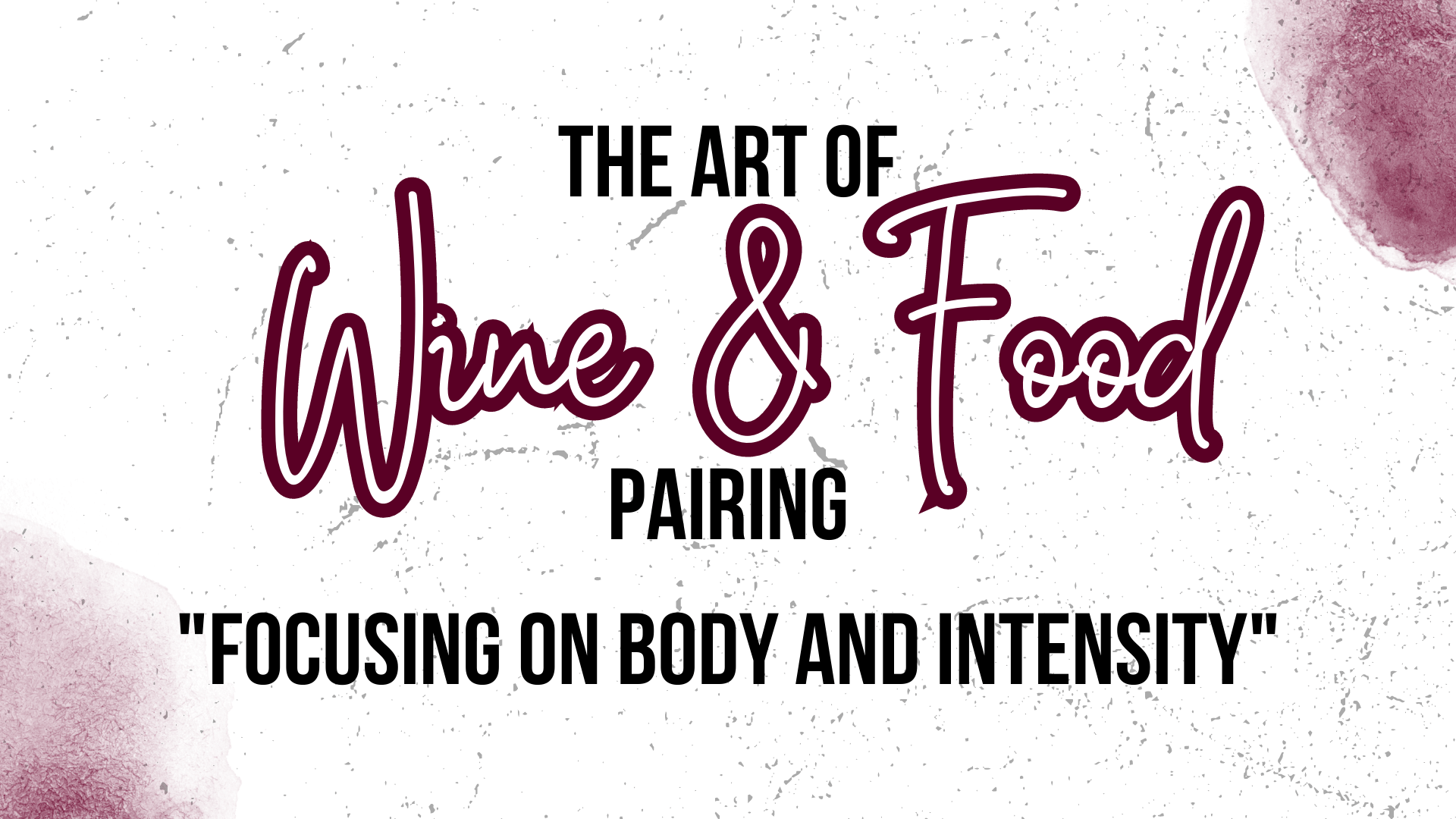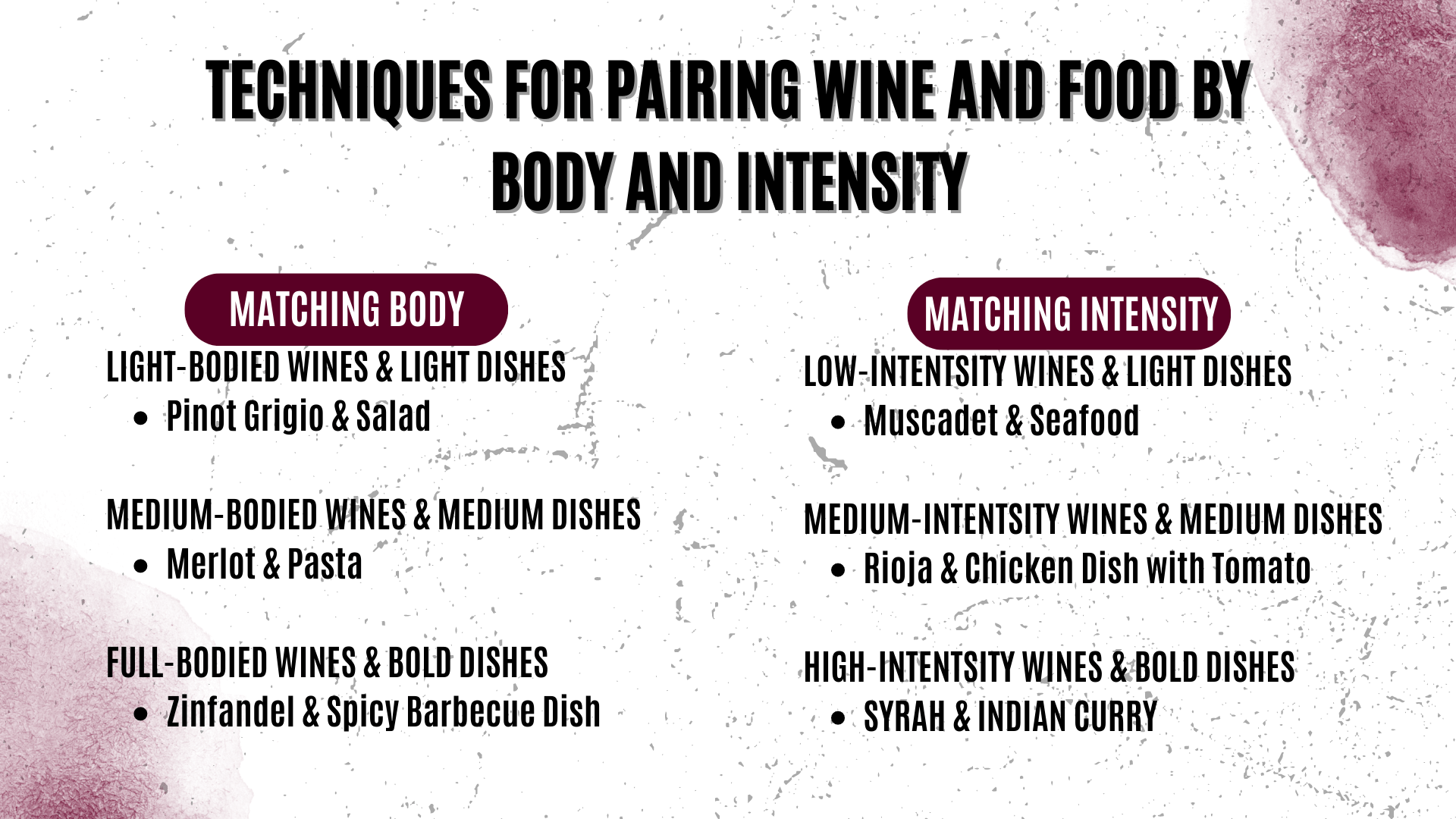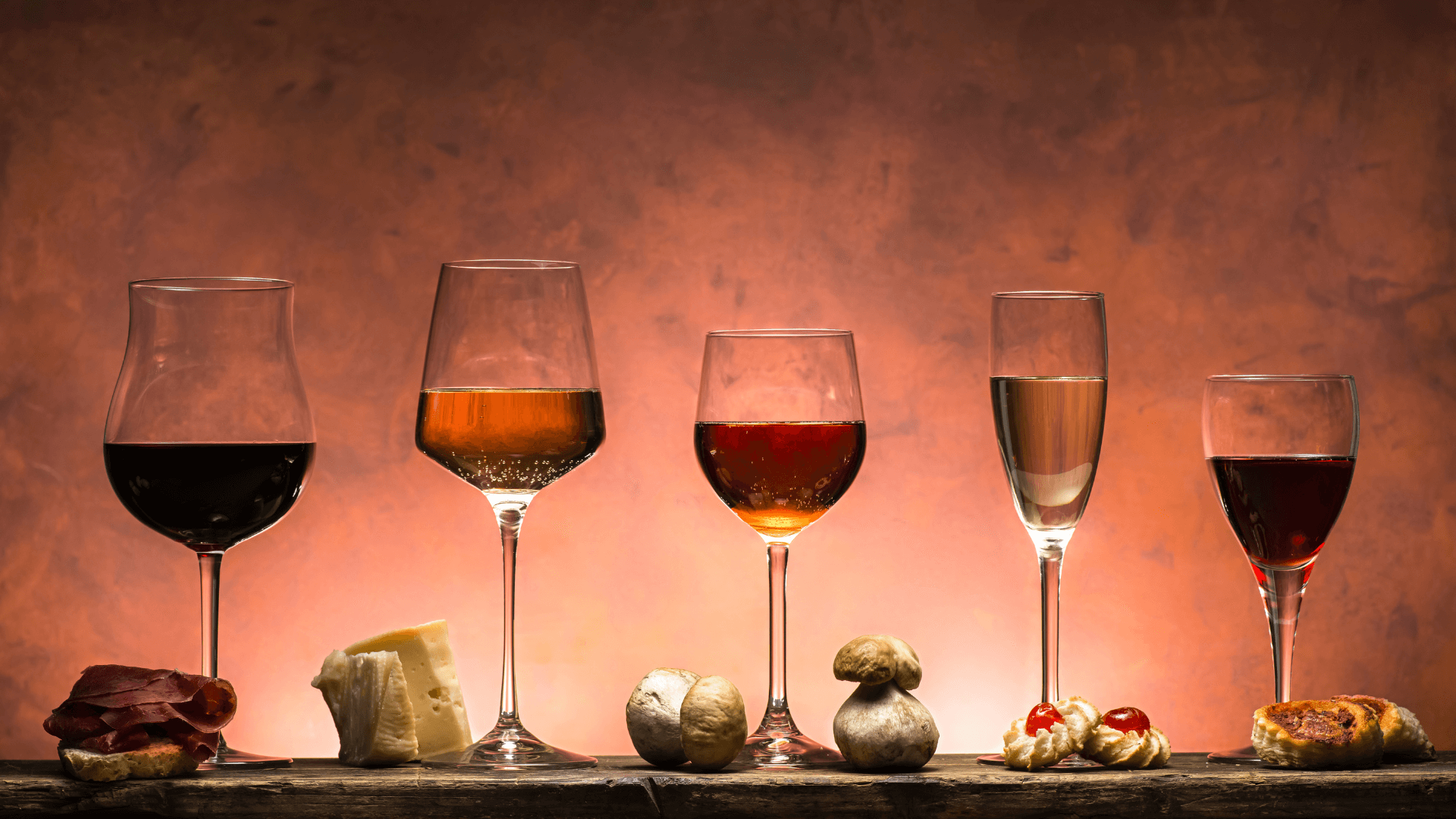Introduction
When it comes to creating harmonious wine and food pairings, considering the body and intensity of both elements is crucial. By understanding these aspects, you can create pairings that complement and enhance each other, leading to a more enjoyable dining experience. This guide will help you understand the concepts of body and intensity in both wine and food, and provide techniques and tips for creating successful pairings based on these factors.
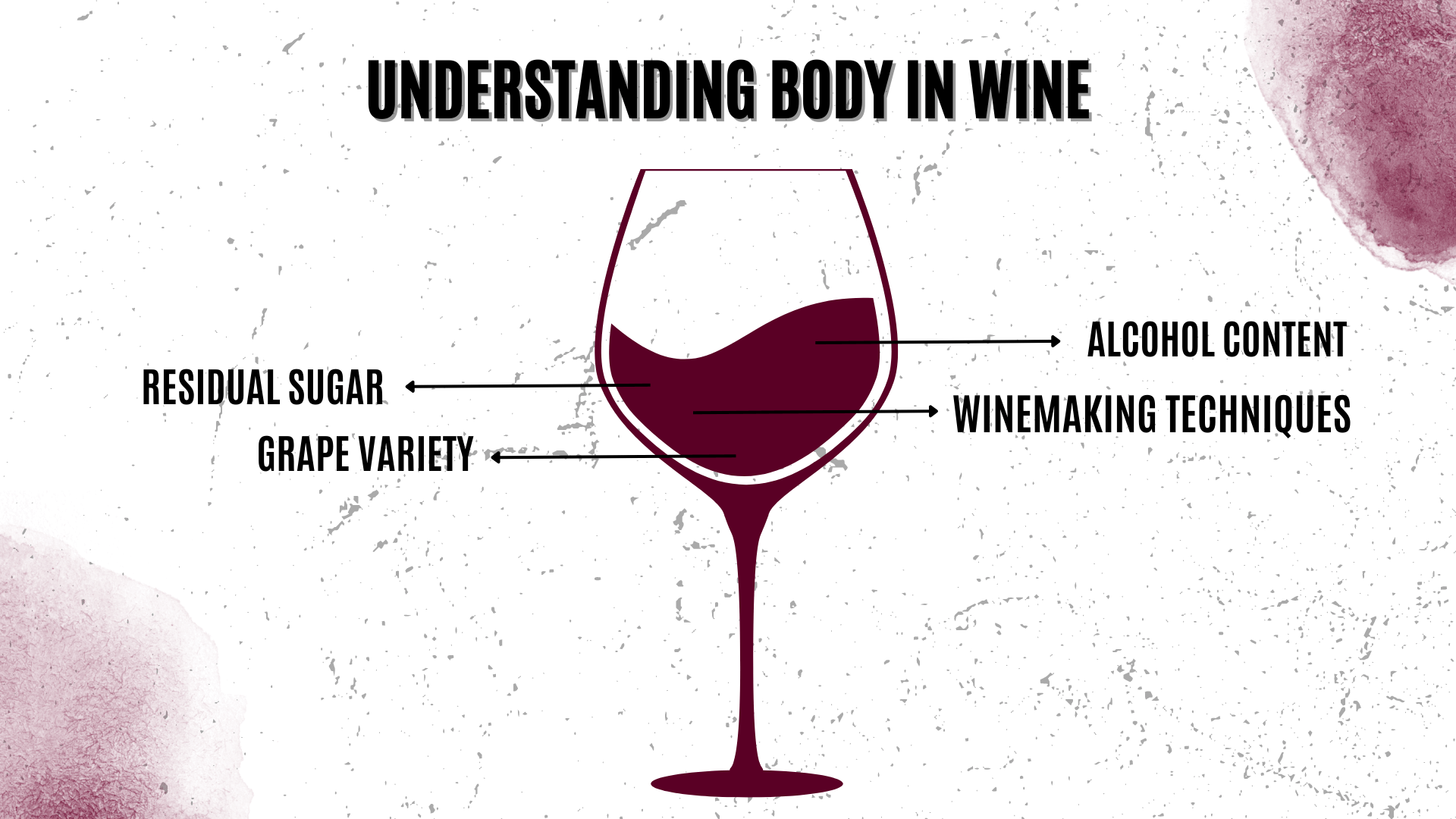
I. Understanding Body in Wine
The body of a wine refers to its weight, mouthfeel, and overall presence on the palate. It is an essential aspect to consider when pairing wine with food, as it helps to create a harmonious balance between the two. Here, we delve deeper into the factors that contribute to a wine’s body and the various classifications based on body.
A. Factors Contributing to Wine Body
- Alcohol Content: Higher alcohol levels can create a more substantial and warming mouthfeel, contributing to a fuller body.
- Grape Variety: Certain grape varieties naturally have more body than others, such as Cabernet Sauvignon compared to Pinot Noir.
- Winemaking Techniques: Practices like malolactic fermentation, lees aging, and oak barrel aging can enhance the body of a wine.
- Residual Sugar: Wines with higher residual sugar levels can feel richer and heavier on the palate.
B. Wine Body Classifications
- Light-bodied wines are typically characterized by their delicate, refreshing mouthfeel and lower alcohol content. Examples include Pinot Grigio, Sauvignon Blanc, and some lighter styles of Pinot Noir.
- Medium-bodied wines offer a balance between light and full-bodied wines, with a bit more weight and complexity on the palate. These wines may include Chardonnay, Merlot, and Sangiovese.
- Full-bodied wines are rich, bold, and often have higher alcohol levels, giving them a more substantial mouthfeel. Examples include Cabernet Sauvignon, Syrah, and full-bodied Zinfandels.
C. Assessing Wine Body
To accurately assess a wine’s body, consider swirling the wine in the glass and observing its appearance. Wines with higher viscosity will leave thicker “legs” or “tears” on the glass, often indicating a fuller body. Additionally, when tasting the wine, pay attention to its weight and texture on the palate, as this will help you determine whether it’s light, medium, or full-bodied.
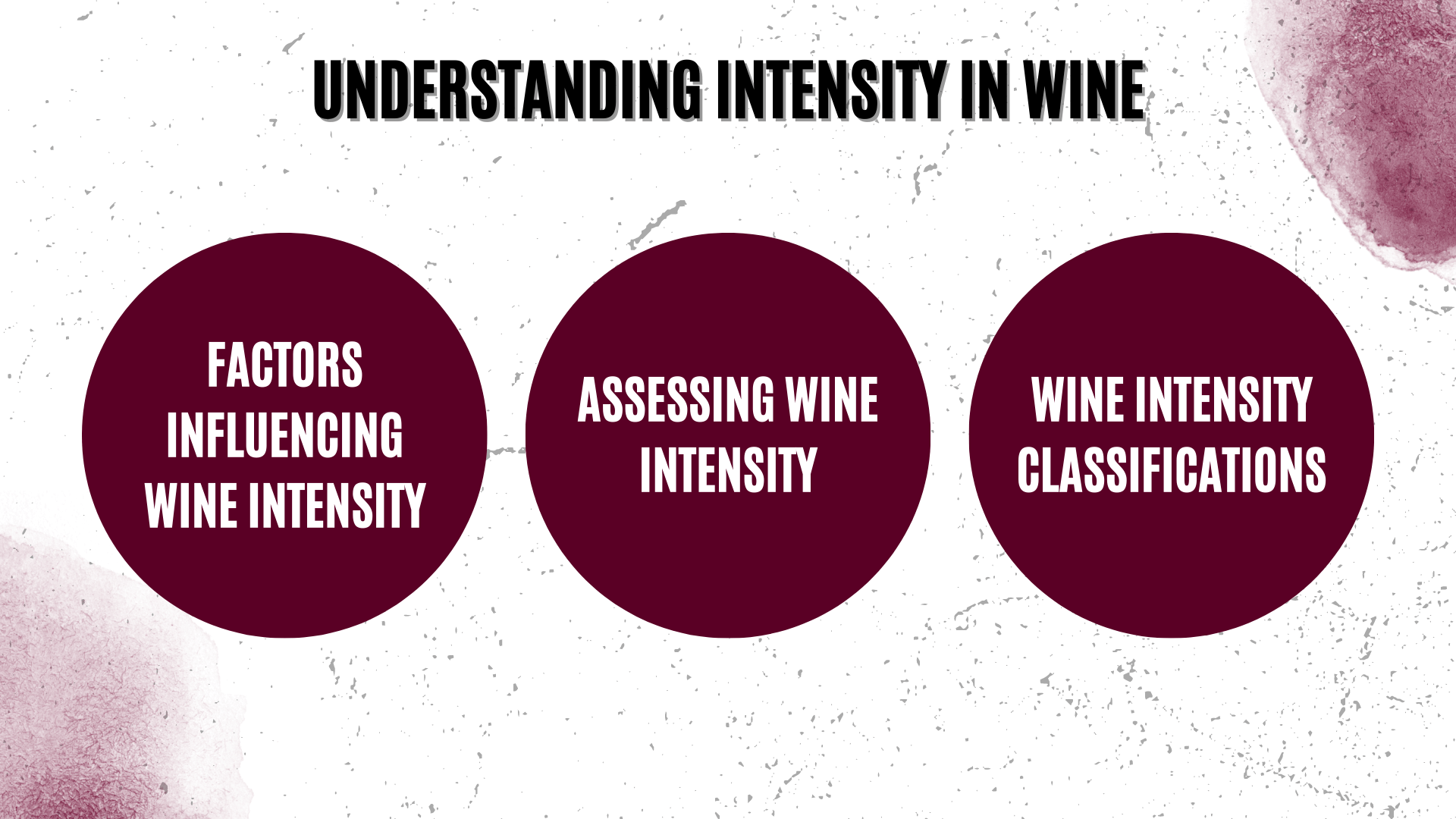
II. Understanding Intensity in Wine
Intensity in wine refers to the concentration of flavors, aromas, and overall character that a wine presents. It is a crucial factor to consider when pairing wine with food, as it helps ensure that neither the wine nor the dish overpowers the other. In this section, we will explore the factors that influence a wine’s intensity, as well as how to assess and classify wine intensity levels.
A. Factors Influencing Wine Intensity
- Grape Variety: Some grape varieties are more expressive and have a more pronounced flavor profile than others, resulting in wines with greater intensity.
- Terroir: The growing conditions, soil, and climate of the vineyard can significantly impact a wine’s intensity by affecting the grape’s ripeness and flavor development.
- Winemaking Techniques: The winemaker’s choices during the winemaking process, such as fermentation temperature, maceration time, and oak aging, can all influence a wine’s intensity.
- Vintage Variation: The conditions of a specific growing season can affect grape ripeness, leading to variations in the intensity of the resulting wines.
B. Assessing Wine Intensity
When evaluating a wine’s intensity, consider both the aroma and the flavor concentration. On the nose, a wine with high intensity will have powerful and pronounced aromas, while a low-intensity wine will present more subtle, delicate aromas. On the palate, assess the concentration and depth of flavors, as well as the length of the finish. A wine with high intensity will offer a more robust, layered, and persistent flavor experience.
C. Wine Intensity Classifications
- Low-intensity wines are delicate and subtle, with nuanced flavors and aromas. These wines often pair well with lighter dishes, such as salads, seafood, or mild cheeses. Examples of low-intensity wines include Muscadet, Vermentino, and some Pinot Noirs.
- Medium-intensity wines offer a balance between subtlety and power, with a moderate concentration of flavors and aromas. These wines can pair well with a wide range of dishes, from poultry to pasta. Examples include Chardonnay, Rioja, and some Merlots.
- High-intensity wines are bold and expressive, with a strong concentration of flavors and aromas. They often pair well with robust, flavorful dishes, such as grilled meats, spicy cuisine, or strong cheeses. Examples include Cabernet Sauvignon, Syrah, and Amarone.
III. Techniques for Pairing Wine and Food by Body and Intensity
Creating harmonious wine and food pairings based on body and intensity requires a thoughtful approach. By taking into account the weight and intensity of both the wine and the dish, you can ensure that neither element overpowers the other. In this section, we will explore various techniques for pairing wine and food by body and intensity.
A. Matching Body
- Light-bodied wines are typically best paired with lighter dishes, as their delicate flavors can be overwhelmed by heavier or more intense dishes. Examples of light-bodied wine pairings include Pinot Grigio with a simple salad or a crisp Sauvignon Blanc with a delicate white fish dish.
- Medium-bodied wines offer more versatility in pairing, as their balanced character can complement a wide range of dishes. Consider matching a medium-bodied Chardonnay with roasted chicken or a smooth Merlot with a hearty pasta dish.
- Full-bodied wines are bold and powerful, making them well-suited to pairing with rich, flavorful dishes. Try a full-bodied Cabernet Sauvignon with a juicy steak or a robust Zinfandel with a spicy barbecue dish.
B. Matching Intensity
- Pair low-intensity wines with dishes that feature subtle flavors, so as not to overpower the wine. For example, a delicate Muscadet would pair well with a light seafood dish or a simple salad with a mild vinaigrette.
- Medium-intensity wines can handle more flavorful dishes, so consider pairing them with dishes that have a moderate level of flavor intensity. A balanced Rioja could be a great match for a flavorful chicken dish with a tomato-based sauce.
- High-intensity wines can stand up to bold, powerful dishes, so don’t be afraid to pair them with robust flavors. A full-bodied Syrah would be an excellent choice for a rich lamb stew or a spicy Indian curry.
C. Tips for Successful Pairing by Body and Intensity
- Consider the overall profile of the wine, including factors such as acidity, tannins, and sweetness, in addition to body and intensity when creating pairings.
- Keep in mind that some wines may fall between categories, offering a unique opportunity for more adventurous pairings.
- Experiment with different pairings to discover your personal preferences and expand your palate.
- Don’t be afraid to break traditional pairing rules and try unconventional matches based on body and intensity.
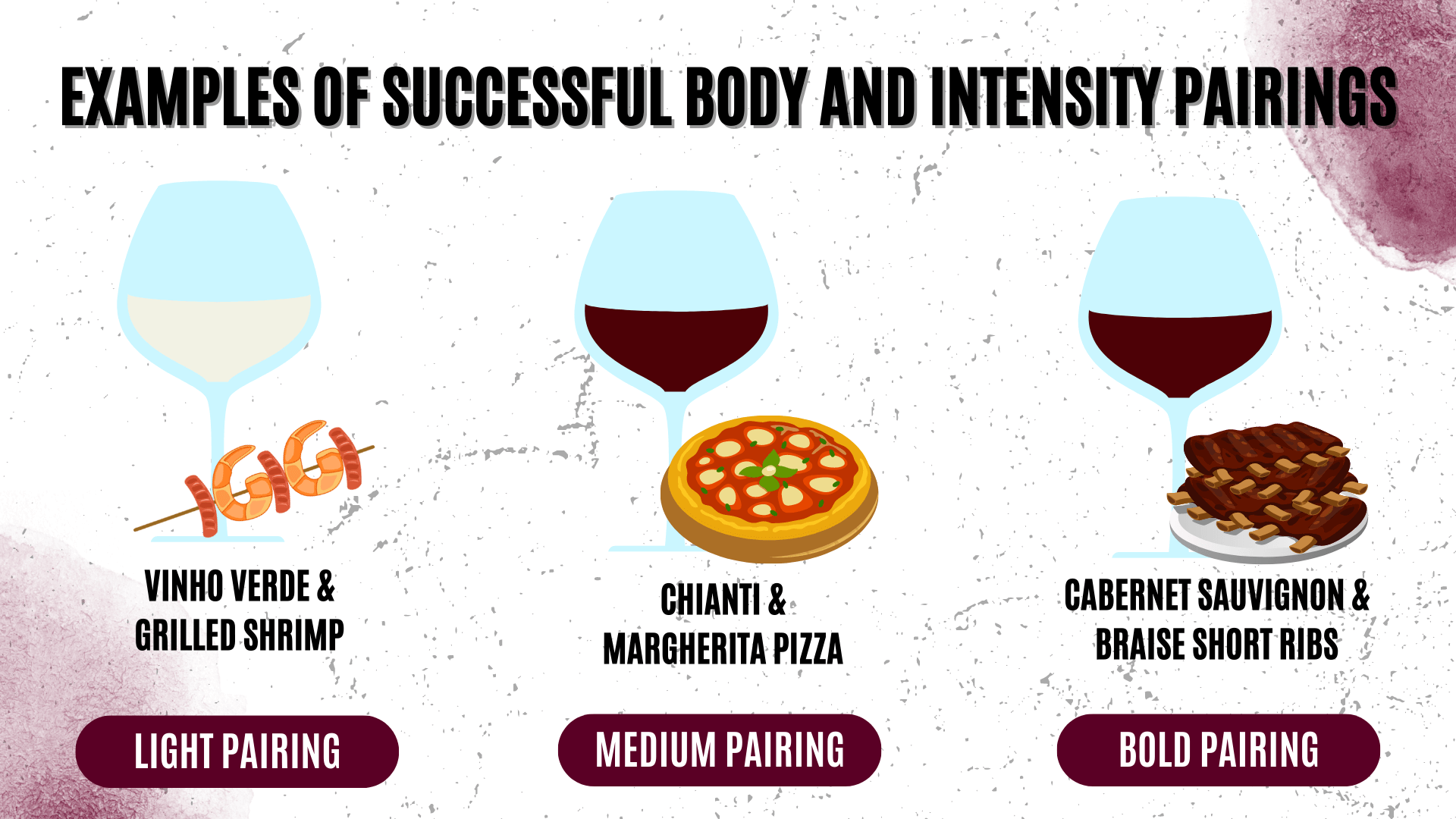
IV. Examples of Successful Body and Intensity Pairings
To better understand how to create successful pairings based on body and intensity, let’s explore some examples that showcase the harmony achieved by carefully considering these factors:
A. Light-bodied Wine Pairings
- Vinho Verde and Grilled Shrimp: The light, zesty character of Vinho Verde pairs beautifully with the delicate flavor and texture of grilled shrimp, creating a refreshing and enjoyable combination.
- Riesling and Vietnamese Spring Rolls: The subtle sweetness and low intensity of a Riesling complement the fresh, vibrant flavors of Vietnamese spring rolls, resulting in a well-balanced and delightful pairing.
B. Medium-bodied Wine Pairings
- Chianti and Margherita Pizza: The medium body and moderate intensity of a Chianti wine pair well with the classic flavors of a Margherita pizza, balancing the acidity of the tomatoes and the richness of the cheese.
- Pinot Noir and Roasted Duck: The earthy, medium-bodied characteristics of Pinot Noir work harmoniously with the richness and complexity of roasted duck, creating a satisfying and complementary pairing.
C. Full-bodied Wine Pairings
- Cabernet Sauvignon and Braised Short Ribs: The full body and high intensity of a Cabernet Sauvignon can stand up to the bold, rich flavors of braised short ribs, resulting in a powerful and indulgent combination.
- Malbec and Grilled Steak: The robust, full-bodied nature of Malbec makes it a perfect match for a flavorful grilled steak, as the wine’s intensity can hold its own against the rich, meaty flavors of the dish.
Conclusion
Mastering the art of pairing wine and food by body and intensity can greatly enhance your dining experiences and elevate the enjoyment of both the wine and the dish. By understanding the concepts of body and intensity in wine and food, and learning how to create harmonious pairings that complement and balance each other, you can unlock a world of delightful flavor combinations.
Remember, finding the perfect pairing is a personal journey that involves experimentation, curiosity, and an open mind. So, don’t be afraid to think outside the box and explore unconventional pairings that may surprise and delight your taste buds. Ultimately, the goal is to discover pairings that resonate with your unique preferences and create memorable culinary experiences.
Cheers to your continued exploration and enjoyment of the fascinating world of wine and food pairing!
Frequently Asked Questions
Pairing wine and food by body and intensity is important because it helps to create balanced and harmonious combinations that enhance the overall dining experience. When the body and intensity of the wine match the weight and intensity of the dish, it ensures that neither the wine nor the food overpowers the other, allowing both elements to shine.
The body of a wine refers to its weight or mouthfeel, which is influenced by factors such as alcohol content, tannins, and acidity. To determine the body of a wine, consider its texture and how it feels on your palate. Wines are typically classified as light-bodied, medium-bodied, or full-bodied.
The intensity of a wine refers to the strength or concentration of its flavors and aromas. To determine the intensity of a wine, pay attention to how pronounced the flavors and aromas are on your palate and nose. Wines can range from low intensity, with delicate and subtle flavors, to high intensity, with bold and assertive flavors.
While it is generally recommended to match the body of the wine with the weight of the dish, it is possible to create successful pairings that break this rule. The key is to ensure that the flavors and intensity levels are complementary and balanced. Experimenting with unconventional pairings can lead to unique and surprising flavor combinations that may work well for your personal preferences.
Light-bodied wines include Pinot Noir, Beaujolais, and Sauvignon Blanc. Medium-bodied wines encompass Merlot, Chardonnay, and Riesling. Full-bodied wines include Cabernet Sauvignon, Syrah, and Malbec.
Yes, the cooking method can significantly impact the intensity of a dish. For example, grilling can impart a charred, smoky flavor that may increase the intensity of a dish, while poaching or steaming can result in more delicate and subtle flavors. The choice of cooking method should be considered when creating pairings based on body and intensity.


